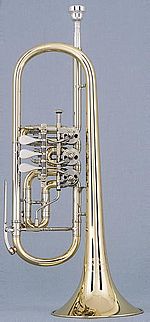trumpet players are generally adept at transposing music at sight, sometimes playing music written for the B-flat trumpet on the C trumpet, and vice versa.
Each trumpet's range extends from the written F sharp immediately below Middle C up to about three octaves higher. Standard repertoire rarely calls for notes beyond this range, and the fingering tables of most method books peak at the C (high C) two octaves above middle C. Several trumpeters have achieved fame for their proficiency in the extreme high register, among them Andrea Tofanelli, Bill Chase, Roger Ingram, Maynard Ferguson, Wayne Bergeron, Dizzy Gillespie, Jon Faddis, Cat Anderson, James Morrison,and Arturo Sandoval. It is also possible to produce pedal tones below the low F sharp, although this technique is more often encountered as a sound-production exercise rather than as a written trumpet part.
The smallest trumpets are referred to as piccolo trumpets. The most common of these are built to play in both B-flat and A, with separate leadpipes for each key. The tubing in the B-flat piccolo trumpet is one-half the length of that in a standard B-flat trumpet. Piccolo trumpets in G, F and even C are also manufactured, but are rarer. Many players use a smaller mouthpiece on the piccolo trumpet. Because of the smaller mouthpiece size, endurance is often limited and the sound production technique is different from that used on the B-flat trumpet. Almost all piccolo trumpets have four valves instead of the usual three: the fourth valve lowers the pitch, usually by a fourth, to facilitate the playing of lower notes. Maurice André, Håkan Hardenberger, and Wynton Marsalis are some well-known piccolo trumpet players.
Trumpets pitched in the key of G are also called sopranos, or soprano bugles, after their adaptation from military bugles. Traditionally used in drum and bugle corps, sopranos have featured both rotary valves and piston valves.
The bass trumpet is usually played by a trombone player, being at the same pitch and using a similar mouthpiece. Bass trumpet is played with a trombone or euphonium mouthpiece, and music for it is written in treble clef.
The modern slide trumpet is a B-flat trumpet that has a slide instead of valves. It is similar to a soprano trombone. The first slide trumpets emerged during the Renaissance, predating the modern trombone, and are the first attempts to increase chromaticism on the instrument. Slide trumpets were the first trumpets allowed in the Christian church.[1]
The historical slide trumpet probably was first developed in the late fourteenth century, for use in alta capella wind bands. Deriving from early straight trumpets, the Renaissance slide trumpet was essentially a natural trumpet with a sliding leadpipe. This single slide was rather awkward, as the entire corpus of the instrument moved; also, the range of this slide was probably no more than a major third. Originals were probably pitched in D, to fit with shawms in D and G - probably at a typical pitch standard near A=466. As no instruments from this period are known to survive, the details - and even the existence - of a Renaissance slide trumpet is a matter of some conjecture, and there continues to be some debate among scholars.[citation needed]
Some slide trumpet designs saw use in England in the eighteenth century; the 'tromba da tirarsi' called for in some Bach cantatas may also have been some manner of slide trumpet.[citation needed]
The pocket trumpet is a compact B-flat trumpet. The bell is usually smaller than a standard trumpet and the tubing is more tightly wound to reduce the instrument size without reducing the total tube length. Its design is not standardized, and the quality of various models varies greatly. It can have a tone quality and projection unique in the trumpet world: a warm sound and a voice-like articulation. Unfortunately, since many pocket trumpet models suffer from poor design as well as cheap and sloppy manufacturing, the intonation, tone color and dynamic range of such instruments are severely hindered. Professional-standard instruments are, however, available. While they are not a substitute for the full-sized instrument, they can be useful in certain contexts.
There are also rotary-valve, or German, trumpets, as well as alto and Baroque trumpets.
The trumpet is often confused with its close relative, the cornet, which has a more conical tubing shape compared to the trumpet's more cylindrical tube. This, along with additional bends in the cornet's tubing, gives the cornet a slightly mellower tone, but the instruments are otherwise nearly identical. They have the same length of tubing and, therefore, the same pitch, so music written for cornet and trumpet is interchangeable. Another relative, the flugelhorn, has tubing that is even more conical than that of the cornet, and an even richer tone. It is sometimes augmented with a fourth valve to improve the intonation of some lower notes.

